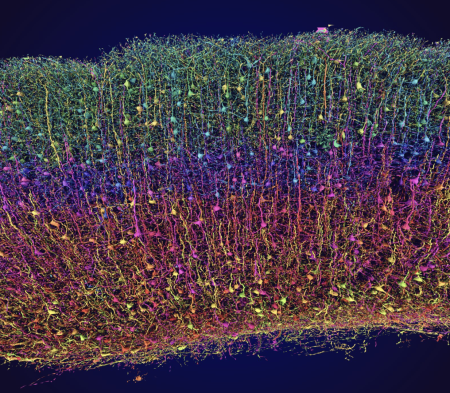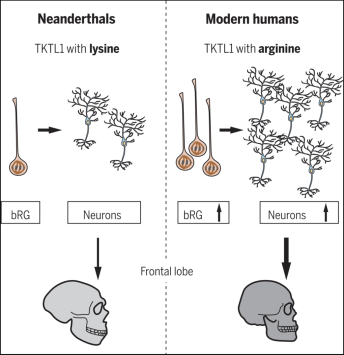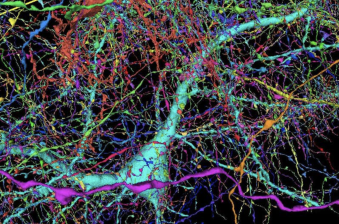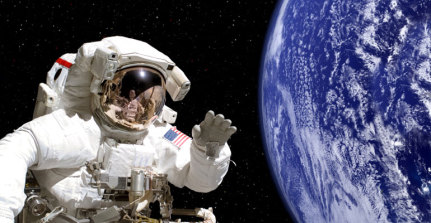
https://www.nature.com/immersive/d42859-025-00001-w/index.html
https://www.youtube.com/watch?v=TxxqLk1xNmM&t=39s
The MICrONS Project (150 researchers): an unprecedented data set of high resolution anatomical images of individual cells in mouse visual cortex, mapped on to their reponses. This integrated view of function and structure lays a foundation for discovering the computational bases of cortical circuits. The resulting data set includes 200 000 cells and 523 million connections in the primary visual cortex and surrounding areas of a mouse: 1mm3 cortex. 04/25
https://cloud.mrc-lmb.cam.ac.uk/s/KC7TPYGtWBdQAeX
The connectome of an insect brain.
Des chercheurs ont réussi à dresser une carte du cerveau d'une mouche : plus de 3000 neurones reliés par 550 000 synapses. Cela donne en effet la première cartographie complète d’un cerveau d’animal complexe. Les mouches sont capables d’apprendre à naviguer dans des environnements variés, à se battre contre des rivaux, autrement dit c’est déjà un cerveau qui "réfléchit", en quelque sorte. Les chercheurs parlent pour la mouche du « plus simple des cerveaux complexes ». Les chercheurs ont pu établir que 75% des neurones sont associés à l’apprentissage et aux circuits de la récompense. Dans le cerveau des mouches, ces deux fonctions clés mobilisent énormément de ressources. Ils ont aussi identifié une sorte de hub neuronal : un circuit très dense de synapses autour de la région cérébrale consacrée à l’apprentissage. Le cerveau se concentre là-dessus. Les chercheurs ont aussi pu détailler comment les deux hémisphères du cerveau se coordonnent. Ils ont pu distinguer les différents types de neurones : il y a 93 familles, qui ont des morphologies différentes. C’est vraiment la première fois qu’on atteint ce niveau de détails. On est bien loin de ces expériences où on a seulement une grande zone du cerveau qui s’allume. Des moyens énormes pour ces 3000 neurones : le cerveau des mouches a été scanné en milliers de tranches avec un microscope électronique à haute résolution. L’humain c’est 85 milliards de neurones (rien que la souris, 70 millions)! 03/23
Researchers have succeeded in mapping the brain of a fly: more than 3,000 neurons linked by 550,000 synapses. This is the first complete mapping of a complex animal brain. Flies are capable of learning to navigate in a variety of environments, to fight against rivals - in other words, it's already a "thinking" brain. Researchers refer to the fly as "the simplest of complex brains". They have established that 75% of neurons are associated with learning and rewarding systems. In the fly brain, these two key functions require enormous resources. They also identified a kind of neuronal hub: a very dense circuit of synapses around the brain region devoted to learning. The brain concentrates on this. The researchers were also able to detail how the two hemispheres of the brain coordinate, and to distinguish between different types of neurons (93 different types). It's really the first time a such intricate map of the brain is established (compared to the studies of our brain with only aeras lighting up). The flies' brains were scanned in thousands of slices using a high-resolution electron microscope. Humans have 85 billion neurons (mice alone have 70 million)! To be continued...
TKTL1 and hominn cortical neurogenesis.
The single lysine-to-arginine substitution in modern human TKTL1 leads to generate more neocortical neurons because TKTL1 expression in fetal human neocortex is particularly high in the developing frontal lobe, these findings imply that the frontal lobe of modern humans contains more neurons than that of Neanderthals.
https://www.science.org/doi/10.1126/science.abl6422
In human line, our ancestors, there was a constant increase in brain size, which is also found in Homo sapiens and Homo neandertalis. Neanderthals even had larger brains than us. Nonetheless, over the last 30,000 years, our Homo sapiens brains have not increased in size, but rather shrunk! So how can we explain its sophistication? Researchers worked on organoid brains, studying a gene involved in brain development, the TK-TL1 gene, and its different versions. They found that the Homo sapiens version produces more neurons and a greater connection between these neurons, particularly in the frontal lobe cortex, an area involved in high cognitive functions such as reasoning and decision-making. This confirms the aberration of the neuromyth "the bigger your brain, the smarter you are." 09/22
Chez les hominines, nos ancêtres, il y a eu une augmentation constante de la taille du cerveau, ce que l'on retrouve aussi chez nous Homo sapiens et chez Homo neandertalis. Les néandertaliens ont même un cerveau plus gros que le notre. Pourtant depuis 30 000 ans, notre cerveau d'Homo sapiens n'augmente plus de taille et se réduit! Comment ainsi expliquer sa sophistication? Des chercheurs ont travaillé sur des cerveaux organoides en étudiant un gène impliqué dans le développement cérébral, le gène TK-TL1 et ses différentes versions. Ils ont pu constaté que la version Homo sapiens produit plus de neurones et une plus grande connexion entre ces neurones notamment dans le cortex du lobe frontal, zone impliqué dans des hautes fonctions cogntitives comme le raisonnement ou la prise de décision. Cela confirme l'aberration du neuromythe "Plus on a un gros cerveau et plus on est intelligent."
https://research.google/blog/a-browsable-petascale-reconstruction-of-the-human-cortex/
Google and researchers from Harvard University produced the most detailed map of brain connections ever, based on a human brain sample: this 3D brain map contains 50,000 neurons linked together to form 130 millions connections at synapse level, and numerous details ranging from neuronal connection patterns to myelin distribution and blood vessels. The data set corresponds to 1.4 petabytes (1 petabyte = 1 million billion bytes) or 700 times the storage capacity of an average computer. This is the first time researchers are capable of seeing the organization and structure of such a large portion of the brain - 1 cubic millimeter!
Google et des chercheurs de l'Université de Harvard ont réalisé la carte la plus détaillée de connexions cérébrales en se basant sur un échantillon de cerveau humain: cette carte cérébrale 3D contient 50 000 neurones reliés formant ainsi 130 millions de connexions au niveau de synapses et de nombreux détails allant des schémas de connexions neuronales à la distribution de la myéline, en passant par les vaisseaux sanguins. L'ensemble des données correspond à 1.4 pétaoctets (1 pétaoctet= 1 million de milliards d'octets) soit 700 fois la capacité de stockage d'un ordinateur moyen. C'est la première fois que les chercheurs peuvent voir l'organisation et la structure d'une aussi grande portion de cerveau soit 1 millimètre cube! Juin/21
https://www.nature.com/articles/s41526-016-0001-9
Thomas Pesquet returned after more than 196 days in space aboard the ISS (International Spatial Station). "Being an astronaut is definitely a risky
job, particularly for the neurons", reveals a study carried out by NASA and the University of Michigan. The researchers observed by an MRI that astronauts got a flattened frontal lobe after a two-week stay on board a space shuttle, or six months in the ISS. Their front part of the brain, the frontal and
temporal cortex, decreased in volume. The cortex is an envelope around 3 millimetres thick that forms the outer part of the brain and is responsible for essential
functions such as abstraction, planning, making decisions, memory. In astronauts, it is thinner because, due to zero gravity, the cerebrospinal fluid is no longer attracted downwards and its
pressure increasing into the cranial skull compresses the front of the brain. A development of motor areas is also noticed: in the
part of the brain located at the top of the skull, a thickening is observed, more specifically in the motor cortex, dedicated to the control of leg movements and the sensations
produced in the legs. Used to supporting the weight of the body, the legs become almost useless in space. The brain modifies its connections to feel them and adjust their
movements to the new environment. This "rewiring" results in the creation of more connections between neurons, which take up more space. All this is made possible thanks to neural
plasticity!
If humans ever take to the stars, it will be with a different brain...
Retour de Thomas Pesquet après plus de 196 jours dans l'espace à bord de l'ISS. Astronaute est décidément un métier à risques, notamment pour les neurones, révèle une étude réalisée par la Nasa et l'université du Michigan. Les chercheurs ont placé des astronautes dans une IRM, après un séjour de deux semaines à bord d'une navette spatiale, ou de six mois dans l'ISS. Résultats: un lobe frontal applati, la partie antérieure du cerveau, le cortex frontal et temporal, a diminué de volume. Le cortex est une enveloppe épaisse d'environ 3 millimètres qui forme la partie externe du cerveau et assure des fonctions essentielles comme l'abstraction, la planification, les mouvements, la mémoire, la vision et l'audition. Chez les astronautes, elle est amincie car, du fait de l'apesanteur, le liquide céphalorachidien n'est plus attiré vers le bas du corps et sa pression augmente dans la boite crânienne, comprimant l'avant du cerveau. Un développement des zones motrices: dans la portion du cerveau située sur le haut du crâne, c'est au contraire un épaississement qui est observé, plus précisément dans le cortex moteur, dédié au contrôle des mouvements des jambes, et aux sensations produites au niveau de celles-ci. En effet, c'est pour les jambes que les choses changent le plus lors d'un voyage spatial. Habituées à soutenir le poids du corps, les voilà presque inutiles. Le cerveau modifie alors ses connexions pour essayer à la fois de les sentir et d'ajuster leurs mouvements à ce nouvel environnement. Ces recâblages se traduisent par la création de plus nombreuses connexions entre neurones, qui prennent plus de place. Tout ceci permis grâce à la plasticité cérébrale!
Si l'humanité prend un jour le chemin des étoiles, ce sera avec un autre cerveau...




